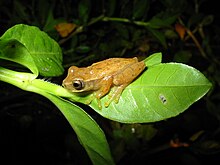| Dendropsophus branneri | |
|---|---|

| |
| Scientific classification | |
| Domain: | Eukaryota |
| Kingdom: | Animalia |
| Phylum: | Chordata |
| Class: | Amphibia |
| Order: | Anura |
| Family: | Hylidae |
| Genus: | Dendropsophus |
| Species: | D. branneri
|
| Binomial name | |
| Dendropsophus branneri (Cochran, 1948)
| |
| Synonyms[2] | |
Dendropsophus branneri is a small hylid tree frog endemic to the Atlantic Forest region of Brazil.[3] It feeds mainly on arthropods[4] and is preyed upon by various invertebrates (e.g., giant aquatic bugs, spiders) and vertebrates (e.g., snakes, birds).[5] Although currently classified by the IUCN Redlist as "least concern",[1] D. branneri suffers rapid habitat loss due to residential development, agriculture, logging, and clearing for pastureland.[3][6] Male D. branneri are noted for their fighting call, which differs significantly in frequency, duration, and pulses per call compared to their mate advertisement call.[7] Males are also noted for their willingness to escalate physical altercations against other males, which includes kicking, pushing, and wrestling their opponent into non-dominant positions.[7] Unlike most other frog species, D. branneri can breed in both temporary and permanent pools allowing it to inhabit a wide variety of habitats leading to its wide distribution.[8]
- ^ a b Gonçalves da Cruz, Carlos Alberto; Potsch de Carvalho-e-Silva, Sergio; Andrade, Gilda (2004). "Dendropsophus branneri". IUCN Red List of Threatened Species. 2004: e.T55420A11306454. doi:10.2305/IUCN.UK.2004.RLTS.T55420A11306454.en. Retrieved 15 November 2021.
- ^ Cite error: The named reference
Frostwas invoked but never defined (see the help page). - ^ a b Santa, Diego José (January 13, 2010). "Anurans in the region of the High Muriaé River, state of Minas Gerais, Brazil". Herpetology Notes. 3 (1): 1–10 – via Research Gate.
- ^ Castro, Indira Maria (May 30, 2016). "Diet of Dendropsophus branneri (Cochran, 1948) (Anura: Hylidae) from a cocoa plantation in southern Bahia, Brazil". North-Western Journal of Zoology. 12 (1): 159–165 – via Research Gate.
- ^ Menin, Marcelo; Rodrigues, Domingos De Jesus; Azevedo, Clarissa Salette de (2005-06-01). "Predation on amphibians by spiders (Arachnida, Araneae) in the Neotropical region". Phyllomedusa: Journal of Herpetology. 4 (1): 39. doi:10.11606/issn.2316-9079.v4i1p39-47. ISSN 2316-9079.
- ^ Martini, Adriana Maria Zanforlin; Fiaschi, Pedro; Amorim, André M.; Paixão, José Lima da (May 31, 2007). "A hot-point within a hot-spot: a high diversity site in Brazil's Atlantic Forest". Biodiversity and Conservation. 16 (11): 3111–3128. Bibcode:2007BiCon..16.3111M. doi:10.1007/s10531-007-9166-6. ISSN 0960-3115. S2CID 11864079.
- ^ a b Aguiar, Pedro Lopes; Souza, Raphael Felipe; De Oliveira, Eduardo Borges; Nali, Renato Christensen (2022-03-07). "Male aggressiveness in the tree frog Dendropsophus branneri (Anura, Hylidae): Physical combat, fighting call, and escalated behavior". Caldasia. 44 (1): 203–207. doi:10.15446/caldasia.v44n1.88112. ISSN 2357-3759. S2CID 252834216.
- ^ Cite error: The named reference
Baracho-2014was invoked but never defined (see the help page).
